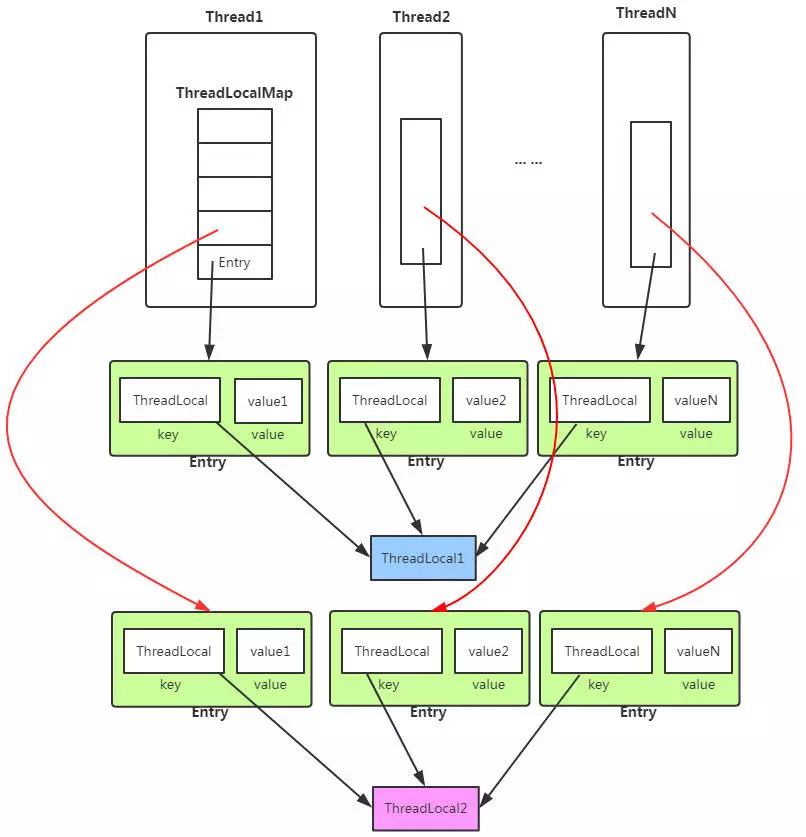ThreadLocal ——android消息机制handler在非主线程创建not called Looper.prepare() 错误的原因
引用自:https://www.jianshu.com/p/a8fa72e708d3
引出:
使用Handler的时候,其必须要跟一个Looper绑定。在UI线程可直接初始化Handler来使用。但是在非主线程中直接new Handler() 会报错: E/AndroidRuntime( 6173): Uncaught handler: thread Thread-8 exiting due to uncaught exception E/AndroidRuntime( 6173): java.lang.RuntimeException: Can't create handler inside thread that has not called Looper.prepare()
原因是非主线程中默认没有创建Looper对象,需要先调用Looper.prepare()启用Looper。 当初始化Handler的时候,其会通过Looper来获取当前的Looper,代码如下:
public Handler(Callback callback, boolean async) {
//省略
mLooper = Looper.myLooper();
if (mLooper == null) {
throw new RuntimeException(
"Can't create handler inside thread that has not called Looper.prepare()");
}
//省略
}
那么,问题来了,为什么在子线程中,通过Looper.myLooper()方法获取的就是为空呢?如果有人回答了Looper是线程相绑定的,那它是如何做到绑定的? 如果还知道答案的话,那就可以跳过本篇文章了。
代码分析
1. Looper的myLooper方法
public static @Nullable Looper myLooper() {
return sThreadLocal.get();
}
此方法只是通过从变量sThreadLocal中取出一个值。那么它的值是哪里来的呢?
2. Looper的prepare方法
private static void prepare(boolean quitAllowed) {
if (sThreadLocal.get() != null) {
throw new RuntimeException("Only one Looper may be created per thread");
}
sThreadLocal.set(new Looper(quitAllowed));
}
可以看出的是调用了这个方法之后,会在sThreadLocal中存在一个新建的Looper对象。那么看看这个sThreadLocal是什么东西呢?
ThreadLocal分析:
1. 定义 (本地线程副本变量工具类)
先看一下官方的解释:
Implements a thread-local storage, that is, a variable for which each thread
has its own value. All threads share the same {@code ThreadLocal} object,
but each sees a different value when accessing it, and changes made by one
thread do not affect the other threads. The implementation supports
{@code null} values.
这段话的意思是实现了一个线程相关的存储,即每个线程都有自己独立的变量。所有的线程都共享着这一个ThreadLocal对象,
并且当一个线程的值发生改变之后,不会影响其他的线程的值。
threadlocal是一个范型类,这标志着threadlocal可以存储所有数据,作为存储数据来说,我们首先想到的是会对外提供set(),get(),remove(),等方法,顺着我们的想法来看源码,果然如此。
2. 核心机制

ThreadLocal的核心机制:
- 每个Thread线程内部都有一个Map。
- Map里面存储线程本地对象(key)和线程的变量副本(value)
- 但是,Thread内部的Map是由ThreadLocal维护的,由ThreadLocal负责向map获取和设置线程的变量值。
3. 实现
ThreadLocal的类定义使用了泛型ThreadLocal<T>,其中T指代的是在线程中存取值的类型。(对应Android中使用的ThreadLocal, T则存放的类型为Looper)
- set方法
/**
* Sets the current thread's copy of this thread-local variable
* to the specified value. Most subclasses will have no need to
* override this method, relying solely on the {@link #initialValue}
* method to set the values of thread-locals.
*
* @param value the value to be stored in the current thread's copy of
* this thread-local.
*/
public void set(T value) {
Thread t = Thread.currentThread();
ThreadLocalMap map = getMap(t);
if (map != null)
map.set(this, value);
else
createMap(t, value);
} ThreadLocalMap getMap(Thread t) {
return t.threadLocals;
} void createMap(Thread t, T firstValue) {
t.threadLocals = new ThreadLocalMap(this, firstValue);
}
步骤:
1.获取当前线程的成员变量map
2.map非空,则重新将ThreadLocal和新的value副本放入到map中。
3.map空,则对线程的成员变量ThreadLocalMap进行初始化创建,并将ThreadLocal和value副本放入map中。
- get方法
/**
* Returns the value in the current thread's copy of this
* thread-local variable. If the variable has no value for the
* current thread, it is first initialized to the value returned
* by an invocation of the {@link #initialValue} method.
*
* @return the current thread's value of this thread-local
*/
public T get() {
Thread t = Thread.currentThread();
ThreadLocalMap map = getMap(t);
if (map != null) {
ThreadLocalMap.Entry e = map.getEntry(this);
if (e != null)
return (T)e.value;
}
return setInitialValue();
} ThreadLocalMap getMap(Thread t) {
return t.threadLocals;
} private T setInitialValue() {
T value = initialValue();
Thread t = Thread.currentThread();
ThreadLocalMap map = getMap(t);
if (map != null)
map.set(this, value);
else
createMap(t, value);
return value;
} protected T initialValue() {
return null;
}
1.获取当前线程的ThreadLocalMap对象threadLocals
2.从map中获取线程存储的K-V Entry节点。
3.从Entry节点获取存储的Value副本值返回。
4.map为空的话返回初始值null,即线程变量副本为null,在使用时需要注意判断NullPointerException。
remove()方法
public void remove() {
ThreadLocalMap m = getMap(Thread.currentThread());
if (m != null)
m.remove(this);
}
ThreadLocalMap getMap(Thread t) {
return t.threadLocals;
}
---------------------
Thread线程内部的Map在类中描述如下:
public class Thread implements Runnable {
/* ThreadLocal values pertaining to this thread. This map is maintained
* by the ThreadLocal class. */
ThreadLocal.ThreadLocalMap threadLocals = null;
}
总结
举例:
package test;
import test.*;
public class Test {
static final ThreadLocal<ThreadValue> mThreadLocal = new ThreadLocal<ThreadValue>();
/**
* @param args
*/
public static void main(String[] args) {
// TODO Auto-generated method stub
ThreadValue threadValue = new ThreadValue("主线程");
mThreadLocal.set(threadValue);
System.out.print("in main thread : mThreadLocal:" + mThreadLocal +"\n");
System.out.print("in main thread : 名字:" + mThreadLocal.get().name +"\n");
mThreadLocal.get().print();
new Thread(new Runnable() {
@Override
public void run() {
ThreadValue childThreadValue = new ThreadValue("子线程");
mThreadLocal.set(childThreadValue);
System.out.print("in child thread : mThreadLocal:" + mThreadLocal +"\n");
System.out.print("in child thread : 名字:" + mThreadLocal.get().name +"\n");
mThreadLocal.get().print();
}
}).start();
}
}
package test;
public class ThreadValue {
String name;
public ThreadValue() {
}
public ThreadValue(String name) {
this.name=name;
}
public void print()
{
System.out.print("this = " + this+" \n");
}
}
结果:
然后编译:javac test/*.java
运行:java test.Test
输出:
in main thread : mThreadLocal:java.lang.ThreadLocal@788bf135
in main thread : 名字:主线程
this = test.ThreadValue@2b890c67
in child thread : mThreadLocal:java.lang.ThreadLocal@788bf135
in child thread : 名字:子线程
this = test.ThreadValue@4f93b604
可以看出由于mThreadLocal定义为静态最终变量,所以在主线程和子线程中,mThreadLocal都是同一个实例。
但是在两个线程中调用mThreadLocal.get(),得到的ThreadValue对象却并不相同。
这是因为mThreadLocal.get(),取到的对象是线程内的局部变量,相互之间并不干扰。
---------------------
作者:??-D-Luffy
来源:CSDN
原文:https://blog.csdn.net/zyfzhangyafei/article/details/64927617
版权声明:本文为博主原创文章,转载请附上博文链接!
ThreadLocal ——android消息机制handler在非主线程创建not called Looper.prepare() 错误的原因的更多相关文章
- Android消息机制——Handler
/**android的消息处理有三个核心类:Looper,Handler和Message.其实还有一个MessageQueue(消息队列), * 但是MessageQueue被封装到Looper里 ...
- Android消息机制
每一个Android应用在启动的时候都会创建一个线程,这个线程被称为主线程或者UI线程,Android应用的所有操作默认都会运行在这个线程中. 但是当我们想要进行数据请求,图片下载,或者其他耗时操作时 ...
- 在非主线程里面使用NSTimer创建和取消定时任务
为什么要在非主线程创建NSTimer 将 timer 添加到主线程的Runloop里面本身会增加线程负荷 如果主线程因为某些原因阻塞卡顿了,timer 定时任务触发的时间精度肯定也会受到影响 有些定时 ...
- Android消息机制:Looper,MessageQueue,Message与handler
Android消息机制好多人都讲过,但是自己去翻源码的时候才能明白. 今天试着讲一下,因为目标是讲清楚整体逻辑,所以不追究细节. Message是消息机制的核心,所以从Message讲起. 1.Mes ...
- Android开发之漫漫长途 ⅥI——Android消息机制(Looper Handler MessageQueue Message)
该文章是一个系列文章,是本人在Android开发的漫漫长途上的一点感想和记录,我会尽量按照先易后难的顺序进行编写该系列.该系列引用了<Android开发艺术探索>以及<深入理解And ...
- Android开发之漫漫长途 Ⅶ——Android消息机制(Looper Handler MessageQueue Message)
该文章是一个系列文章,是本人在Android开发的漫漫长途上的一点感想和记录,我会尽量按照先易后难的顺序进行编写该系列.该系列引用了<Android开发艺术探索>以及<深入理解And ...
- Android消息机制之ThreadLocal的工作原理
来源: http://blog.csdn.net/singwhatiwanna/article/details/48350919 很多人认为Handler的作用是更新UI,这说的的确没错,但是更新UI ...
- Android 进阶14:源码解读 Android 消息机制( Message MessageQueue Handler Looper)
不要心急,一点一点的进步才是最靠谱的. 读完本文你将了解: 前言 Message 如何获取一个消息 Messageobtain 消息的回收利用 MessageQueue MessageQueue 的属 ...
- Android消息机制探索(Handler,Looper,Message,MessageQueue)
概览 Android消息机制是Android操作系统中比较重要的一块.具体使用方法在这里不再阐述,可以参考Android的官方开发文档. 消息机制的主要用途有两方面: 1.线程之间的通信.比如在子线程 ...
随机推荐
- Elasticsearch之优化
为什么es需要优化? 答: [root@master elasticsearch-2.4.0]# ulimit -a core file size (blocks, -c) 0 data seg si ...
- 尚硅谷springboot学习5-主入口类说明
package com.atguigu; import org.springframework.boot.SpringApplication; import org.springframework.b ...
- 访问Nginx报错
今天新装Nginx,一切妥善后,访问虚拟机服务器的IP,结果发现响应超时 这是因为防火墙的80端口没有打开,在新装的Linux上搭服务器一般会遇到这个问题,重新开放80端口即可解决: (1)firew ...
- nginx+php 开启https
nginx 配置如下,配置好重启nginx,不是nginx -s reload,如果还不能访问肯定就是防火墙问题,关闭防火墙再试试. 我遇到的问题是:我服务器是ecs,域名解析到阿里云复杂均衡的,结果 ...
- Bash 翻译
Bash参考手册 目录 1简介 1.1什么是Bash? 1.2什么是shell? 2定义 3基本外壳功能 3.1 Shell语法 3.1.1外壳操作 3.1.2报价 3.1.2.1逃逸角色 3.1.2 ...
- avalon2学习教程01
经过难苦奋战,avalon2终于面世了.这花了大半年时间,其中1.6还胎死腹中.长达半年没有产出,我都担心自己会被裁掉…… avalon2许多API与1.4.×保持一致,当然也添加了一些1.5的功能, ...
- sql help cs
using System;using System.Collections.Generic;using System.Linq;using System.Text;using System.Confi ...
- TLS协议工作过程;如何应用TLS/SSL协议为WEB流量提供安全
SSL/TLS协议的基本过程是这样的: 客户端向服务器端索要并验证公钥. 双方协商生成"对话密钥". 双方采用"对话密钥"进行加密通信. 上面过程的前两 ...
- django 认证系统--1
django的认证系统提供认证和授权两种功能 认证系统包括如下部分: 1.Users 2.Permissions 主要是以 YES/NO 的形式反映一个用户是否能够做某事 3.Groups:就是对多个 ...
- MVC part4
SpringMVC 注解 @Controller 负责注册一个bean 到spring 上下文中,bean 的ID 默认为类名称开头字母小写,你也可以自己指定, 如下 方法一: @Controller ...
